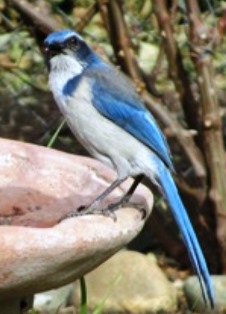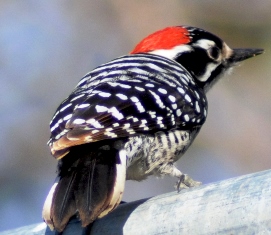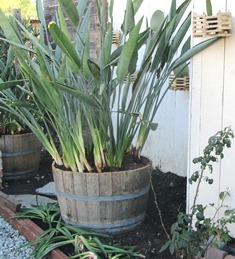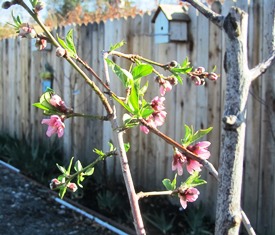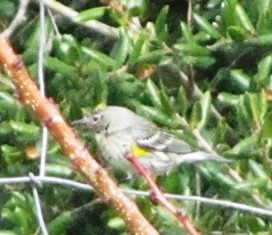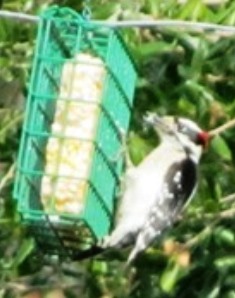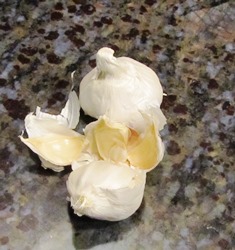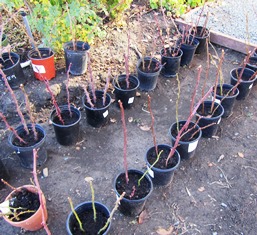Archive for January, 2014
Pair Bonding and Nest Building Is for the Birds
Nothing is sweeter to this farmette owner’s ears that the trills, tweets, and peet-a-weets of the backyard songbirds. Of late, we’ve been highly entertained, especially since the male songbirds seem to be in courtship mode, singing and doing air acrobatics in an effort to woo a female into bonding with them. Nest building comes after that.
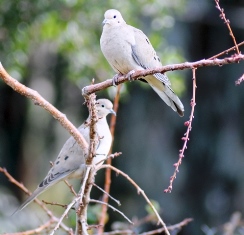
Mourning Doves mate for life; these two are joined at the feeder by a third who has lost her partner
The Mourning Doves sound their plaintive call during flight or at rest on a wire waiting for the right time to alight on the ground, which is where they prefer to feed. Lately, however, I’ve seen a pair feeding together in the tight space around a feeder. Of late, a third has joined them.
The Western Scrub Jay isn’t really a songbird. He competes with the mockingbird, who is especially vocal, for the highest perch in the tree where it sits lookout and squawks until it spots an acorn and swoops down to take it in its beak for burial, most likely somewhere in my yard. At first, we saw only one or two jays and now there are four or more hanging out near the many feeders and suet cakes that we’ve hung for the birds.
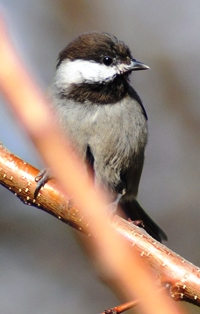
The Gray-headed Chickadee’s habitat is in northwestern Canada and Alaska, so what’s it doing on a Bay Area farmette?
The above bird passed through and posed long enough for a picture in our apricot tree. We think it is a Gray-headed Chickadee, but when we look the bird up in the Audubon book, it seemed unlikely since that bird doesn’t travel through Northern California. Still, the image of our bird seems to match exactly that of a Gray-headed Chickadee.
The flashiest bird of all in our backyard hangs upside down at the suet box, pecking away at the embedded seeds and pieces of fruit in the suet cake. He’s the Nuttall’s woodpecker and he’s found a mate. She’s hanging around, scouting out nesting sites. We’re trying to deter them from using a hole in our old farmette roof strut, but I think we’re losing the battle. Every morning, we hear the rat-ta-tat-tatting of bird beak against wood near the front porch. I’ve covered each hole they’ve made, but they keep drilling new ones.
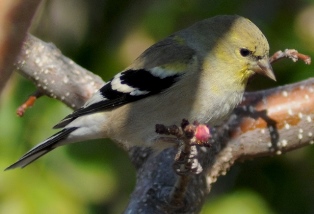
The Pine Warbler perches contentedly in the apricot tree after dining on insects, bugs, larvae, spiders, and caterpillars as well as the fruit and seeds embedded in the suet cake
Another bird that proved difficult for us to identify is the above pictured Pine Warbler. We have a massive pine tree in front of the farmette and with the suet cakes hanging at the back, this guy must have moseyed from the tall pine tree to drop in and taste a bit. These birds sing a rapid 10 to 30 notes at a time, usually on one pitch. Like most songbirds, they have song and also have defensive sounds, like a rattle call or a short, sharp note they sound to warn of predators or danger.
Tell the Plants to Go Back to Sleep . . . It’s Still Winter
It’s beach weather along Northern California’s coastline and bare root season technically won’t start for another few weeks. It’s the last Saturday in January–still winter. But the plants are waking up all around Henny Penny Farmette, thanks to the record-breaking, unseasonably warm weather.

Narcissus are grown from bulbs and when massed together in plantings return year after year in a cheerful splash of color
The narcissus seem to have popped up overnight. We tucked three dozen bulbs in a bed the first fall we lived on the farmette. The next spring, they bloomed. Their tall stalks and leaves die during summer, but every spring they emerge to bloom again, creating a dramatic drift of color.
Who doesn’t love working in shirt sleeves? But our gardens need rain and we need the plants to remain dormant while we finish winter chores and get our new chicken house ready.
This week, we finished dividing the strawberries and irises, cutting back the roses, and spraying the fruit trees again.We created another sitting area in the garden under a large apricot tree, laid a gravel floor, and planted Bird of Paradise (Strelitzia reginae) plants in half barrels.
Bird of Paradise plants (also known as crane flower) are indigenous to South Africa. The plants are heat lovers and aren’t too fussy about soil. Planting them in containers is a good idea if you live in an area, as we do, where the winter temperatures fall below 50 degrees Fahrenheit. You simply move them indoors.
The Bird of Paradise foliage makes a nice foil for the plant’s striking blooms of orange, fuchsia, and purple that resemble a crane’s head and beak.
I think it’s too late to tell the plants to go back to sleep. So even if it’s torture to spend a long, languorous day digging in my garden in my shirt sleeves, while the rest of the country is freezing, I suppose I simply must soldier on.
Yellow-Rumped Warbler and Other Songbirds Act Like It’s Spring
It’s the middle of January but tell that to Mother Nature whose songbirds are singing like it is spring. With our temperatures expected to exceed 70 degrees Fahrenheit in parts of the Bay Area today, the birds are gathering around feeders and fountains and the bees are buzzing about, too.
While having coffee on the patio this morning, I had the privilege of being visited by a variety of winged friends, some seemingly oblivious to me and my camera.
The woodpecker announces himself with the familiar rat-ta-tat-tat while the yellow-rumped warbler and other songbirds hang out in the firethorn bush, in the oak trees, and at several fountains we’ve placed at the rear of our farmette.
There’s a lot of bee traffic today. With warm days forecast for the next week or two, the bees could get the wrong idea and swarm. That would undoubtedly surprise the local backyard bee hobbyists.
So while I love the warm weather–especially when I read about the polar temperatures causing such misery in the Midwest and along the East Coast–like many Californians, I am beginning to worry about the looming possibility of a drought this year and mandatory water rationing.
But, then again, there’s something magical about hearing songbirds trilling in the dead of winter when the fruit trees in the orchard and the roses lining the path to the front door remain soundly asleep. I think I’ll have another cup of coffee and sit for a while longer.
What’s Not to Like about Garlic?
The use of garlic (Allium sativum, an herb) was well known in the ancient world as a flavoring agent for food as well as a powerful medicinal aid. In fact, the ancients believed garlic was especially beneficial in the treatment of such maladies as indigestion, respiratory ailments, parasitic infections, and fatigue.
Modern scientific studies have shown garlic to be an effective agent in reducing blood pressure and high cholesterol. People have also used it in the treatment of tuberculosis, bronchitis, dysentery, liver ailments, diabetes, and rheumatism. Some believe garlic slows the progression of artherosclerosis (hardening of the arteries). Garlic can work like a blood thinner, and thus, it might be a valuable agent in preventing strokes and heart attacks.
Emory University School of Medicine researchers discovered that Diallyl trisulfide found in garlic oil helps to protect the heart during cardiac surgery and after a heart attack. The compound also seems to have cancer fighting properties.
Garlic kills cancer cells in test tubes. It may also lower the risk of developing colon cancer. See, http://umm.edu/health/medical/altmed/herb/garlic
A research study in China used anecdotal evidence to support the belief that eating raw garlic more than twice a week can lower the risk of getting lung cancer by 44 percent. The research was published in the journal Cancer Prevention Research.
Garlic is rich in antioxidants. Garlic oil, according to research published in the Journal of Agriculture and Food Chemistry, potentially could be used to prevent diabetes-induced cardiomyopathy, although the researchers say further study is needed. Diabetics are at higher risk for developing cardiomyopathy, a thickening of the myocardium that makes the heart become enlarged over time and less effective as a pump.
Long valued as an anti-inflammatory agent, garlic also strengthens the immune system. When taken as a prophylactic, garlic is believed to reduce the number of colds people get during the cold and flu season.
I am not a medical doctor but I believe eating a wide variety of herbs, vegetables, fruits, grains, and nuts for their nutritional value. Of course, the closer the food is to being organic and fresh, the better it will be for the body.
Garlic is easy to grow. It needs full sun, good drainage, and rich, loamy soil. In the fall, plant the cloves two inches under the soil and six inches apart clove pointed upward. Water weekly.
The cloves will grow in the spring and are ready to harvest around mid June to July, when roughly 3/4 of the top growth has turned yellow. Hang four to six weeks to cure. Keep a braid of garlic in kitchen for use in your culinary creations.
Preparing for an Early Spring
It’s winter. The nights are cold and the early mornings even colder. But here on the farmette, daytime temps are still unseasonably warm for this time of year in Northern California. That makes doing all the winter cleanup and spring preparation chores not only tolerable, but enjoyable.
We’ve pruned all the roses and taken cuttings for propagation of new bushes that we’ll plant around our property. We’ve divided the irises and planted the babies in new beds. Finally, we tackled pruning the fruit trees and imagine how shocked we were to find our Desert Gold peach trees with buds ready to open. The reason must be the warm weather.
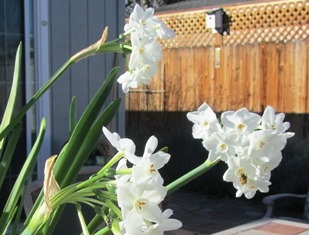
The honeybees are searching for blossoms and finding none, they’re exploring the papaperwhite narcissus on my patio table
The honeybees are searching for flowers in bloom. They’ve flown to the citrus trees that I’ve covered against nighttime freezing temps and are wandering about on the blankets. The French perfume lavender still has some blooms but the bees seem also interested in the paperwhite narcissus blooms that I forced in water between Christmas and New Years Day.
We’ve moved the strawberries to a newly prepared bed in two planter boxes and are revitalizing the soil in the old boxes. Bare root season is around the corner and my husband and I are feeling the pressure to get the garden ready for a new growing season. The days are lengthening and we don’t want an early spring to catch us unprepared. Technically, winter has only just begun but the birds and bees and buds on the trees are suggesting it could be a short winter.
 Facebook
Facebook Goodreads
Goodreads LinkedIn
LinkedIn Meera Lester
Meera Lester Twitter
Twitter




